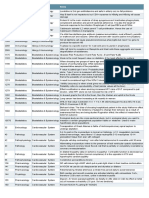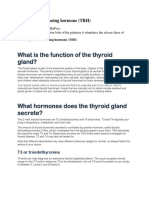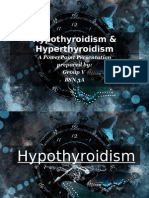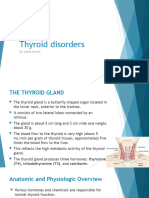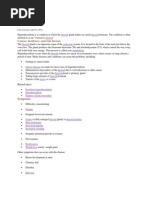Hypothyroidism: Classification
Hypothyroidism: Classification
Uploaded by
pali_sakshamCopyright:
Available Formats
Hypothyroidism: Classification
Hypothyroidism: Classification
Uploaded by
pali_sakshamOriginal Title
Copyright
Available Formats
Share this document
Did you find this document useful?
Is this content inappropriate?
Copyright:
Available Formats
Hypothyroidism: Classification
Hypothyroidism: Classification
Uploaded by
pali_sakshamCopyright:
Available Formats
Hypothyroidism
Hypothyroidism is a condition in which the thyroid gland does not make enough thyroid hormone. Iodine deficiency is often cited as the most common cause of hypothyroidism worldwide but it can be caused by many other factors. It can result from a lack of a thyroid gland or from iodine-131 treatment, and can also be associated with increased stress. Severe hypothyroidism in infants can result in cretinism (Cretinism is a condition of severely stunted physical and mental growth due to untreated congenital deficiency of thyroid hormones usually due to maternal hypothyroidism) .
Classification Hypothyroidism is often classified by association with the indicated organ dysfunction
Type - Primary origin - Thyroid gland The most common forms include Hashimoto's thyroiditis (an autoimmune disease) and radioiodine therapy for hyperthyroidism.
type - Secondary Origin - Pituitary gland Occurs if the pituitary gland does not create enough thyroid-stimulating hormone (TSH) to induce the thyroid gland to produce enough thyroxine and triiodothyronine. Although not every case of secondary hypothyroidism has a clear-cut cause, it is usually caused by damage to the pituitary gland, as by a tumor, radiation, or surgery.Secondary hypothyroidism accounts for less than 5% or 10% of hypothyroidism cases.
Type - Tertiary Origin- Hypothalamus
Results when the hypothalamus fails to produce sufficient thyrotropin-releasing hormone (TRH). TRH prompts the pituitary gland to produce thyroid-stimulating hormone (TSH). Hence may also be termed hypothalamic-pituitary-axis hypothyroidism. It accounts for less than 5% hypothyroidism cases.
Signs and symptoms Early hypothyroidism is often asymptomatic and can have very mild symptoms. Subclinical hypothyroidism is a state of normal thyroid hormone levels, thyroxine (T4) and triiodothyronine (T3), with mild elevation of thyrotropin, thyroid-stimulating hormone (TSH). With higher TSH levels and low free T4 levels, symptoms become more readily apparent in clinical (or overt) hypothyroidism. Hypothyroidism can be associated with the following symptoms: Early Cold intolerance, increased sensitivity to cold Constipation Weight gain and water retention Bradycardia (low heart rate fewer than sixty beats per minute) Fatigue Decreased sweating Muscle cramps and joint pain Dry, itchy skin Thin, brittle fingernails Rapid thoughts Depression Poor muscle tone (muscle hypotonia) Female infertility, any kind of problems with menstrual cycles Hyperprolactinemia and galactorrhea Elevated serum cholesterol
Late Goiter Slow speech and a hoarse, breaking voice deepening of the voice can also be noticed, caused by Reinke's Edema. Dry puffy skin, especially on the face Thinning of the outer third of the eyebrows (sign of Hertoghe) Abnormal menstrual cycles Low basal body temperature Thyroid-Related Depression
Uncommon Impaired memory Impaired cognitive function (brain fog) and inattentiveness. A slow heart rate with ECG changes including low voltage signals. Diminished cardiac output and decreased contractility Reactive (or post-prandial) hypoglycemia Sluggish reflexes Hair loss Anemia caused by impaired haemoglobin synthesis (decreased EPO levels), impaired intestinal iron and folate absorption or B12 deficiency from pernicious anemia Difficulty swallowing Shortness of breath with a shallow and slow respiratory pattern Increased need for sleep Irritability and mood instability Yellowing of the skin due to impaired conversion of beta-carotene to vitamin A (carotoderma)
Impaired renal function with decreased glomerular filtration rate Acute psychosis (myxedema madness) (a rare presentation of hypothyroidism) Decreased libido in men due to impairment of testicular testosterone synthesis Decreased sense of taste and smell (anosmia) Puffy face, hands and feet (late, less common symptoms) Gynecomastia Deafness Enlarged tongue
Subclinical hypothyroidism Subclinical hypothyroidism occurs when thyrotropin (TSH) levels are elevated but thyroxine (T4) and triiodothyronine (T3) levels are normal. In primary hypothyroidism, TSH levels are high and T4 and T3 levels are low. TSH usually increases when T4 and T3 levels drop. TSH prompts the thyroid gland to make more hormone. In subclinical hypothyroidism, TSH is elevated but below the limit representing overt hypothyroidism. The levels of the active hormones will be within the laboratory reference ranges.
Pregnancy and fertility During pregnancy there is a substantially increased need of thyroid hormones and substantial risk that a previously unnoticed, subclinical or latent hypothyroidism will turn into overt hypothyroidism. See thyroid disease in pregnancy for more details. Subclinical hypothyroidism in early pregnancy, compared with normal thyroid function, has been estimated to increase the risk of pre-eclampsia with an odds ratio (OR) of 1.7 and the risk of perinatal mortality with an OR of 2.7. Even mild or subclinical hypothyroidism are known to adversely affect fertility.
Epidemiology 0.3% of the general American population have overt hypothyroidism, and 4.3 % have subclinical hypothyroidism. A 1995 survey in the UK found the mean
incidence (with 95% confidence intervals) of spontaneous hypothyroidism in women was 3.5/1000 survivors/year (2.8-4.5) rising to 4.1/1000 survivors/year (3.3-5.0) for all causes of hypothyroidism and in men was 0.6/1000 survivors/year (0.3-1.2). Estimates of subclinical hypothyroidism range between 38%, increasing with age; incidence is more common in women than in men.
Causes
Iodine deficiency is the most common cause of hypothyroidism worldwide. In iodine-replete individuals hypothyroidism is frequently caused by Hashimoto's thyroiditis, or otherwise as a result of either an absent thyroid gland or a deficiency in stimulating hormones from the hypothalamus or pituitary. Factors such as iodine deficiency or exposure to iodine-131 from nuclear fallout, which is absorbed by the thyroid gland like regular iodide and destroys its cells, can increase the risk. Congenital hypothyroidism is very rare accounting for approximately 0.2% and can have several causes such as thyroid aplasia or defects in the hormone metabolism. Thyroid hormone insensitivity (most often T3 receptor defect) also falls into this category although in this condition the levels of thyroid hormones may be normal or even markedly elevated. Hypothyroidism can result from postpartum thyroiditis, a condition that affects about 5% of all women within a year of giving birth.[citation needed] The first phase is typically hyperthyroidism; the thyroid then either returns to normal, or a woman develops hypothyroidism. Of those women who experience hypothyroidism associated with postpartum thyroiditis, one in five will develop permanent hypothyroidism requiring life-long treatment. Hypothyroidism can result from de Quervain's thyroiditis, which, in turn, is often caused by having a bad flu that enters and destroys part, or all, the thyroid. Hypothyroidism can also result from sporadic inheritance, sometimes autosomal recessive. Temporary hypothyroidism can be due to the Wolff-Chaikoff effect. A very high intake of iodine can be used to temporarily treat hyperthyroidism, especially in an emergency situation. Although iodide is a substrate for thyroid hormones, high levels reduce iodide organification in the thyroid gland, decreasing
hormone production. The antiarrhythmic agent amiodarone can cause hyperor hypothyroidism due to its high iodine content. Hypothyroidism can be caused by lithium-based mood stabilizers, usually used to treat bipolar disorder (previously known as manic depression). In fact, lithium has occasionally been used to treat hyperthyroidism. Other drugs that may produce hypothyroidism include interferon alpha, interleukin-2, and thalidomide.
Stress and hypothyroidism Stress is known to be a significant contributor to thyroid dysfunction: this can be environmental stress as well as lesser-considered homeostatic stress such as fluctuating blood sugar levels and immune problems. Moreover, adrenal stress's effect on thyroid function can be indirect, through its effects on blood sugar levels (dysglycemia), but can also have more direct effects. Stress can cause hypothyroidism or reduced thyroid functioning through disrupting the HPA axis which down-regulates thyroid function, reducing the conversion of T4 to T3, weakening the immune system thus promoting autoimmunity, causing thyroid hormone resistance, and resulting in hormonal imbalances: indeed, excess estrogen in the blood caused by chronic cortisol elevations (which reduce the liver's ability to clear excess estrogen), can result in hypothyroid symptoms by decreasing levels of active T3. Stress also affects thyroid functioning through the sympathetic nervous system. Refugees from East Germany in a 1994 study who experienced chronic stress were found to have a very high rate of hypothyroidism or subclinical hypothyroidism, although not all refugees displayed clinical or behavioral symptoms associated with this reduced thyroid functioning. TSH levels correlate positively with physiological stress. Symptoms of adrenal stress include Fatigue Headaches Decreased immunity Difficulty falling asleep, staying asleep and waking up Mood swings Sugar and caffeine cravings Irritability or lightheadedness between meals
Eating to relieve fatigue Dizziness when moving from sitting or lying to standing Gastric ulcers Weak adrenal glands can also result in hypothyroid symptoms without affecting the thyroid itself.
Diagnosis The only validated test to diagnose primary hypothyroidism, is to measure thyroid-stimulating hormone (TSH) and free thyroxine (T4). However, these levels can be affected by non-thyroidal illnesses. High levels of TSH indicate that the thyroid is not producing sufficient levels of thyroid hormone (mainly as thyroxine (T4) and smaller amounts of triiodothyronine (T3)). However, measuring just TSH fails to diagnose secondary and tertiary hypothyroidism, thus leading to the following suggested blood testing if the TSH is normal and hypothyroidism is still suspected: Free triiodothyronine (fT3) Free thyroxine (fT4) Total T3 Total T4 Additionally, the following measurements may be needed: Free T3 from 24-hour urine catch Antithyroid antibodies for evidence of autoimmune diseases that may be damaging the thyroid gland Serum cholesterol which may be elevated in hypothyroidism Prolactin as a widely available test of pituitary function Testing for anemia, including ferritin Basal body temperature
Treatment
Hypothyroidism is treated with the levorotatory forms of thyroxine (levothyroxine) (L-T4) and triiodothyronine (liothyronine) (L-T3). Synthroid is, in the US, the most common name form of the pill Levothyroxine. Synthroid is also the most common pill prescribed by doctors that has the synthetic thyroid hormone in it. This medicine can improve symptoms of thyroid deficiency such as slow speech, lack of energy, weight gain, hair loss, dry skin, and feeling cold. It also helps to treat goiter. It is also used to treat some kinds of thyroid cancer along with surgery and other medicines. Both synthetic and animalderived thyroid tablets are available and can be prescribed for patients in need of additional thyroid hormone. Thyroid hormone is taken daily, and doctors can monitor blood levels to help assure proper dosing. Levothyroxine is best taken 3060 minutes before breakfast, as some food can diminish absorption. Calcium can inhibit the absorption of levothryoxine. Compared to water, coffee reduces absorption of levothyroxine by about 30 percent. Some patients might appear to be resistant to levothyroxine, when in fact they do not properly absorb the tablets - a problem which is solved by pulverizing the medication. There are several different treatment protocols in thyroid-replacement therapy: T4 only This treatment involves supplementation of levothyroxine alone, in a synthetic form. It is currently the standard treatment in mainstream medicine. T4 and T3 in combination This treatment protocol involves administering both synthetic L-T4 and L-T3 simultaneously in combination. Desiccated thyroid extract Desiccated thyroid extract is an animal-based thyroid extract, most commonly from a porcine source. It is also a combination therapy, containing natural forms of L-T4 and L-T3.
Treatment controversy The potential benefit from substituting some T3 for T4 has been investigated, but no conclusive benefit for combination therapy has been shown. The 2002 Laboratory Medicine Practice Guidelines of the National Academy of Clinical Biochemistry state that during pregnancy: "The L-T4 dose should be increased (usually by 50 mcg/day) to maintain a serum TSH between 0.5 and 2.0 mIU/L and a serum FT4 in the upper third of the normal reference interval." Doctors however often assume that if your TSH is in the "normal range", sometimes defined as high as 5.5 mIu/L, it has no effect on fertility. Healthy
pregnant women however have a TSH level of around 1.0 mIU/L.
Subclinical hypothyroidism There is a range of opinion on the biochemical and symptomatic point at which to treat with levothyroxine, the typical treatment for overt hypothyroidism. Reference ranges have been debated as well. As of 2003, the American Association of Clinical Endocrinologists (ACEE) considers 0.33.0 mIU/L within normal range.There is always the risk of overtreatment and hyperthyroidism. Some studies have suggested that subclinical hypothyroidism does not need to be treated. A 2007 meta-analysis by the Cochrane Collaboration found no benefit of thyroid-hormone replacement except "some parameters of lipid profiles and left-ventricular function." A 2002 meta-analysis looking into whether subclinical hypothyroidism may increase the risk of cardiovascular disease, as has been previously suggested, found a possible modest increase and suggested further studies be undertaken with coronary-heart disease as an end point "before current recommendations are updated.
You might also like
- Step 1 UworldDocument25 pagesStep 1 UworldKarl Abiaad100% (23)
- DR Lal Path Labs TestDocument2 pagesDR Lal Path Labs TestPIVOT GRAVITYNo ratings yet
- Thyroid Disorder in Medical Astrology - Jyotish Surfer PDFDocument40 pagesThyroid Disorder in Medical Astrology - Jyotish Surfer PDFAria AriaNo ratings yet
- Lecture 10 Protein Energy Malnutrition (PEM)Document26 pagesLecture 10 Protein Energy Malnutrition (PEM)jaish8904100% (1)
- Hashimoto's Thyroiditis InfographicDocument2 pagesHashimoto's Thyroiditis InfographicPetraNo ratings yet
- TSSM Unit 1 Exam 2018Document28 pagesTSSM Unit 1 Exam 2018nisulNo ratings yet
- 8.2hypo& HyperthyroidismDocument32 pages8.2hypo& HyperthyroidismMamatha JavvajiNo ratings yet
- HypothyridismDocument18 pagesHypothyridismanuu1404No ratings yet
- Hperthyroidism 1Document4 pagesHperthyroidism 1Salwa KaramanNo ratings yet
- HypothyroidismDocument4 pagesHypothyroidismDennis RosinNo ratings yet
- HPERTHYROIDISMDocument4 pagesHPERTHYROIDISMSalwa KaramanNo ratings yet
- Thyroid Disorders: DR Raghuveer ChoudharyDocument53 pagesThyroid Disorders: DR Raghuveer ChoudharyPhysiology by Dr RaghuveerNo ratings yet
- Endocrinology ThyroidDocument66 pagesEndocrinology ThyroidDr. Manish RamavatNo ratings yet
- HypothyroidismDocument14 pagesHypothyroidismmirmurtazarind82No ratings yet
- Group 4 - Alteration of Hormonal RegulationDocument17 pagesGroup 4 - Alteration of Hormonal RegulationMarcus KaglNo ratings yet
- What Is The Function of The Thyroid Gland?: Thyrotropin-Releasing Hormone (TRH)Document4 pagesWhat Is The Function of The Thyroid Gland?: Thyrotropin-Releasing Hormone (TRH)Jessel Mae JavierNo ratings yet
- Lecture 4Document36 pagesLecture 4tamtamtamtama0No ratings yet
- Hypothyroidis SecondaryDocument4 pagesHypothyroidis SecondaryfynneroNo ratings yet
- CVD & ThyroidDocument12 pagesCVD & ThyroidShang AllertseNo ratings yet
- Hyperthyroidism Vs Hypothyroidism: Ngmontecillo SSLC 1ST SEM 2021-2022Document76 pagesHyperthyroidism Vs Hypothyroidism: Ngmontecillo SSLC 1ST SEM 2021-2022Giovanne BuendiaNo ratings yet
- Hypothyroidism in PregnancyDocument29 pagesHypothyroidism in PregnancyhanaddulNo ratings yet
- Gabriel Chacón - ULA (VE) - Pharmacy - 1041 Physiopathology - Subject 4 - Endocrine DisordersDocument8 pagesGabriel Chacón - ULA (VE) - Pharmacy - 1041 Physiopathology - Subject 4 - Endocrine DisordersGabriel ChacónNo ratings yet
- Hashimoto Thyroiditis, A Simple Guide To The Condition, Treatment And Related ConditionsFrom EverandHashimoto Thyroiditis, A Simple Guide To The Condition, Treatment And Related ConditionsNo ratings yet
- Oral Revalida Round 2Document63 pagesOral Revalida Round 2Mercy Anne EcatNo ratings yet
- Thyroid and ParathyroidDocument29 pagesThyroid and Parathyroidpranutan739No ratings yet
- Etiology-Hypothyroidism: Chronic Autoimmune ThyroiditisDocument4 pagesEtiology-Hypothyroidism: Chronic Autoimmune ThyroiditisNungky KusumaNo ratings yet
- Pathophysiology of EndocrinologyDocument25 pagesPathophysiology of EndocrinologyISRAELNo ratings yet
- Hypothyroidism (Underactive Thyroid) Part 1: Too Little Thyroid HormoneDocument11 pagesHypothyroidism (Underactive Thyroid) Part 1: Too Little Thyroid HormoneRex Bryan RanalanNo ratings yet
- Disorders of The Thyroid1Document22 pagesDisorders of The Thyroid1Saddamix AL OmariNo ratings yet
- PathophysiologyDocument7 pagesPathophysiologyAko Si Vern ÖNo ratings yet
- Hypothyroidism (Underactive Thyroid) - Symptoms, Causes, Tests, TreatmentsDocument9 pagesHypothyroidism (Underactive Thyroid) - Symptoms, Causes, Tests, TreatmentsHannah Denise BatallangNo ratings yet
- Hypothyroidism ConspectDocument6 pagesHypothyroidism ConspectHah LaNo ratings yet
- HypothyroidismDocument7 pagesHypothyroidismNader Smadi100% (2)
- Sumant Sharma MD CIC. Regional Lab Nejran. KKSADocument58 pagesSumant Sharma MD CIC. Regional Lab Nejran. KKSADr Sumant SharmaNo ratings yet
- HASHIMOTODocument13 pagesHASHIMOTOeogundipe61No ratings yet
- Comprehensive Review On Hypothyroid Pathophysiology Etiology ManagementDocument22 pagesComprehensive Review On Hypothyroid Pathophysiology Etiology ManagementVinod ChandraNo ratings yet
- Hyperthyroidism & HypothyroidismDocument109 pagesHyperthyroidism & Hypothyroidismmadelynmas75% (4)
- Presentation 6Document26 pagesPresentation 6555556666667777777No ratings yet
- Hyper OfficeDocument4 pagesHyper Officeshakib33001No ratings yet
- Hypothyroidism - StatPearls - NCBI BookshelfDocument10 pagesHypothyroidism - StatPearls - NCBI BookshelfKarla CordobaNo ratings yet
- Pathophysiology of HyperthyroidismDocument97 pagesPathophysiology of HyperthyroidismMarie Joyce SablanNo ratings yet
- Thyroid Disorders: Dr. Lubna DwerijDocument52 pagesThyroid Disorders: Dr. Lubna DwerijNoor MajaliNo ratings yet
- Hashimoto S ThyroiditisDocument5 pagesHashimoto S ThyroiditisGreggy John Rivera CascayanNo ratings yet
- Thyroid EssayDocument2 pagesThyroid EssayAine Graham100% (1)
- HyperthyroidismDocument12 pagesHyperthyroidismShoppe 'n ShoppersNo ratings yet
- Effects of High TSHDocument3 pagesEffects of High TSHSreream KumarNo ratings yet
- What Is HyperthyroidismDocument7 pagesWhat Is HyperthyroidismGelo LeañoNo ratings yet
- 35thyroid DisordersDocument21 pages35thyroid DisordersDurga VoraNo ratings yet
- Laboratory Assessment of Thyroid FunctionDocument22 pagesLaboratory Assessment of Thyroid FunctionelwinrodriguezNo ratings yet
- What Is HypothyroidismDocument16 pagesWhat Is HypothyroidismvinhannyNo ratings yet
- Functions of The Thyroid GlandDocument3 pagesFunctions of The Thyroid Glandred888342193No ratings yet
- What Is HyperthyroidismDocument7 pagesWhat Is HyperthyroidismBheru LalNo ratings yet
- HipothiroidDocument27 pagesHipothiroidYuji AdityaNo ratings yet
- Yoga and Hyperthyroidism PDFDocument16 pagesYoga and Hyperthyroidism PDFRaushan Kumar MishraNo ratings yet
- EndocrinologyDocument39 pagesEndocrinologySoumyajit Ray ChaudhuriNo ratings yet
- Malfunctioning of The Thyroid GlandDocument20 pagesMalfunctioning of The Thyroid GlandonlyglorylightNo ratings yet
- Hypothyroidism: Special Types of HypothyroidismDocument4 pagesHypothyroidism: Special Types of HypothyroidismVictor VicencioNo ratings yet
- Hypothyroidism: Causes, Incidence, and Risk FactorsDocument5 pagesHypothyroidism: Causes, Incidence, and Risk FactorsPhineas KangoreNo ratings yet
- Wo Week 4 (Hyperthyroidism)Document12 pagesWo Week 4 (Hyperthyroidism)Theddyon BhenlieNo ratings yet
- Thyroid: TRH TSHDocument6 pagesThyroid: TRH TSHAjay Pal NattNo ratings yet
- Underactivity of Thyroid Gland (Hypothyroidism)Document5 pagesUnderactivity of Thyroid Gland (Hypothyroidism)Mohamed Omar SamatarNo ratings yet
- Hypothyroidism: Autoimmune DiseaseDocument3 pagesHypothyroidism: Autoimmune DiseaseAnand SwamiNo ratings yet
- Hypothyroidism, A Simple Guide To The Condition, Treatment And Related ConditionsFrom EverandHypothyroidism, A Simple Guide To The Condition, Treatment And Related ConditionsNo ratings yet
- Thyroid Diet: How to improve and cure thyroid disorders, lose weight, and improve metabolism with the help of food!From EverandThyroid Diet: How to improve and cure thyroid disorders, lose weight, and improve metabolism with the help of food!No ratings yet
- Nomenklatur Alat KesehatanDocument38 pagesNomenklatur Alat KesehatanYudha PrabowoNo ratings yet
- 2023 HeinWCED Life Sciences Grade 12 - JIT Session 3 - 24 May 2023.Pptx 2Document59 pages2023 HeinWCED Life Sciences Grade 12 - JIT Session 3 - 24 May 2023.Pptx 2carolmurendwaNo ratings yet
- Down Syndrome and Thyroid Disorders: A Review: 25 V. P. PrasherDocument18 pagesDown Syndrome and Thyroid Disorders: A Review: 25 V. P. PrasherErNi CiewekwekcrewetNo ratings yet
- ScienceDocument112 pagesScienceAnkit JainNo ratings yet
- Anfis Endokrin S2 (Compatibility Mode) .CompressedDocument66 pagesAnfis Endokrin S2 (Compatibility Mode) .CompressedAmiliya EmilNo ratings yet
- Group 4Document45 pagesGroup 4Nicole Juliette CCNo ratings yet
- Annex 2-2 IFU of RocheDocument4 pagesAnnex 2-2 IFU of Rocheyingchen242No ratings yet
- Basic Medical Endocrinology Fourth EditionDocument33 pagesBasic Medical Endocrinology Fourth EditionIrakanutyun ElNo ratings yet
- CLIA Acceptable Test Performance CriteriaDocument4 pagesCLIA Acceptable Test Performance CriteriaMihaelaHorgaNo ratings yet
- Endo 1.0 - FrameDocument33 pagesEndo 1.0 - FrameIshNo ratings yet
- Labreportnew 6782Document1 pageLabreportnew 6782Shahabuddin AnsariNo ratings yet
- Normal Lab Values UsmleDocument3 pagesNormal Lab Values UsmleAnne Maria50% (2)
- Thyroid HormonesDocument9 pagesThyroid Hormonesftaaa oshaNo ratings yet
- Chapter 39 Endorcrine and Reproductive SystemDocument20 pagesChapter 39 Endorcrine and Reproductive SystemgjaenNo ratings yet
- Key Points - RevisionDocument58 pagesKey Points - RevisionsophieNo ratings yet
- Med Law PerspectivesDocument3 pagesMed Law PerspectivesbiscaynediverNo ratings yet
- GCSE (9-1) Biology ExemplarsDocument51 pagesGCSE (9-1) Biology ExemplarsT-AnimeNo ratings yet
- Product Support Booklet: Lara Briden Endometriosis and PcosDocument24 pagesProduct Support Booklet: Lara Briden Endometriosis and PcosVeronica TestaNo ratings yet
- Does Ashwagandha Side EffectsDocument5 pagesDoes Ashwagandha Side Effectsnvenkatesh485No ratings yet
- Medical Lab Technician: Vocational Curriculum - 2020 2020Document64 pagesMedical Lab Technician: Vocational Curriculum - 2020 2020sm7865143No ratings yet
- Lecture Notes in Medical Technology - Lecture #5 - THYROID FUNCTION TESTSDocument14 pagesLecture Notes in Medical Technology - Lecture #5 - THYROID FUNCTION TESTSKat JornadalNo ratings yet
- Pediatrics Examination ReviewDocument224 pagesPediatrics Examination ReviewMobin Ur Rehman KhanNo ratings yet
- Pediatrics Block 2Document207 pagesPediatrics Block 2Ghada ElhassanNo ratings yet
- Nurseslabs Normal Lab Values 1.2 PDFDocument5 pagesNurseslabs Normal Lab Values 1.2 PDFPrincess BaciaNo ratings yet
- Processes Paper 1&2 Life Sciences Grade 12Document25 pagesProcesses Paper 1&2 Life Sciences Grade 12mongsterbNo ratings yet
